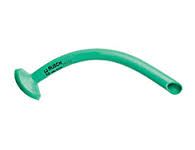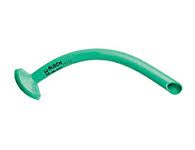NASOPHARYNGEAL AIRWAY, CH26, sterile, s.u.
Valid Article
NASOPHARYNGEAL AIRWAY
Definition
A nasopharyngeal airway (NPA) is a soft, flexible, uncuffed tube placed through the nasal passages so that the distal tip rests in the nasopharynx. It is used to maintain the free passage of air to and from the lungs. The purpose of the flared end is to prevent the device from becoming lost inside the patient's nose.
Synonym
also known as an NPA, nasal trumpet (because of its flared end), or nose hose
Specifications
Quality standards
Technical specifications
- Soft flexible material: thermoplastic elastomer (such as neoprene), PVC, silkolatex, latex-free is preferred
- Rounded, beveled tip
- Trumpet design (Robertazzi type) is the preferred model, the fixed flange type can be used as an alternative.
- 8 sizes: CH20 - CH34
- Length: adult sizes range from 6 to 9 cm.
- 6 to 7 cm in the small adult
- 7 to 8 cm in the medium size adult
- 8 to 9 cm in the large adult.
- Sterile, for single use
Packaging & Labelling
- Unit sterile packaging in peel-open pack
- box of 10 units
Instructions for use
The correct size NPA is chosen by measuring the device on the patient: the device should reach from the patient's nostril to the earlobe or the angle of the jaw. In addition, choose an NPA which has a diameter a little smaller than the patient's nares. The distal tip of the NPA is properly placed beyond the tongue base but should not be in contact with the epiglottis.
CH = FR | Ext Ø mm | Int Ø mm | Length mm |
20 | 5.0 | 100 – 115 | |
22 | 5.5 | 105 – 125 | |
24 | 8.1 | 6.0 | 105 – 125 |
26 | 8.6 | 6.5 | 110 – 140 |
28 | 9.3 - 9.4 | 7.0 | 117 – 155 |
30 | 10.0 | 7.5 | 118 – 165 |
32 | 10.6 - 10.8 | 8.0 | 140 – 170 |
34 | 11.3 | 8.5 | 155 - 170 |
36 | 12.0 | 9.0 | 170 - 180 |
Precautions for Use
Insertion of an NPA is absolutely contraindicated in patients with severe head or facial injuries, or have evidence of a basilar skull fracture due to the possibility of direct intrusion into brain tissue.
MSF requirements
The nasopharyngeal airway has advantages over the oropharyngeal airway (Guedel airway) in certain situations as it can be used in patients with an intact gag reflex, trismus or oral trauma.




